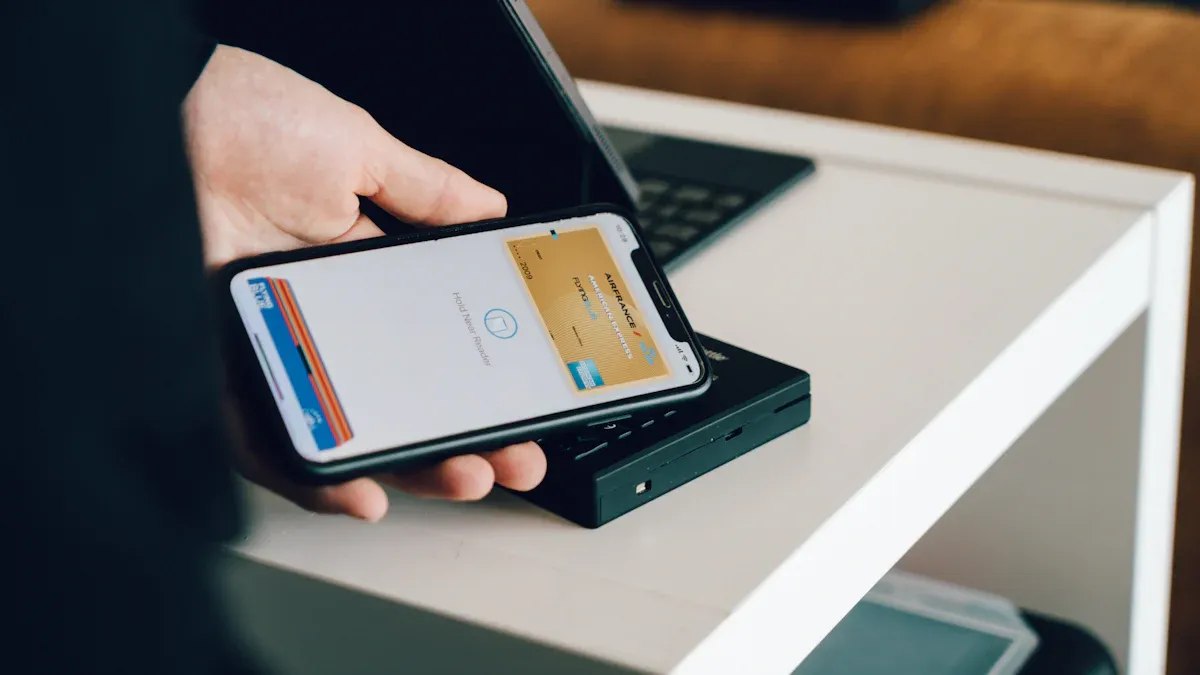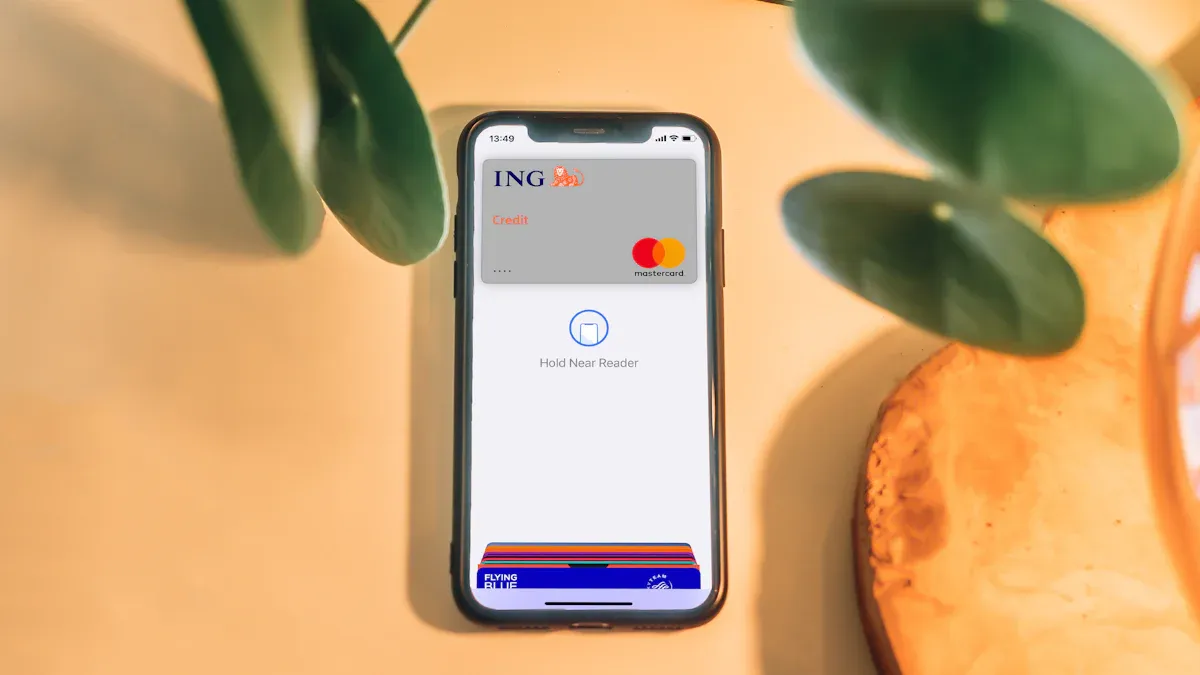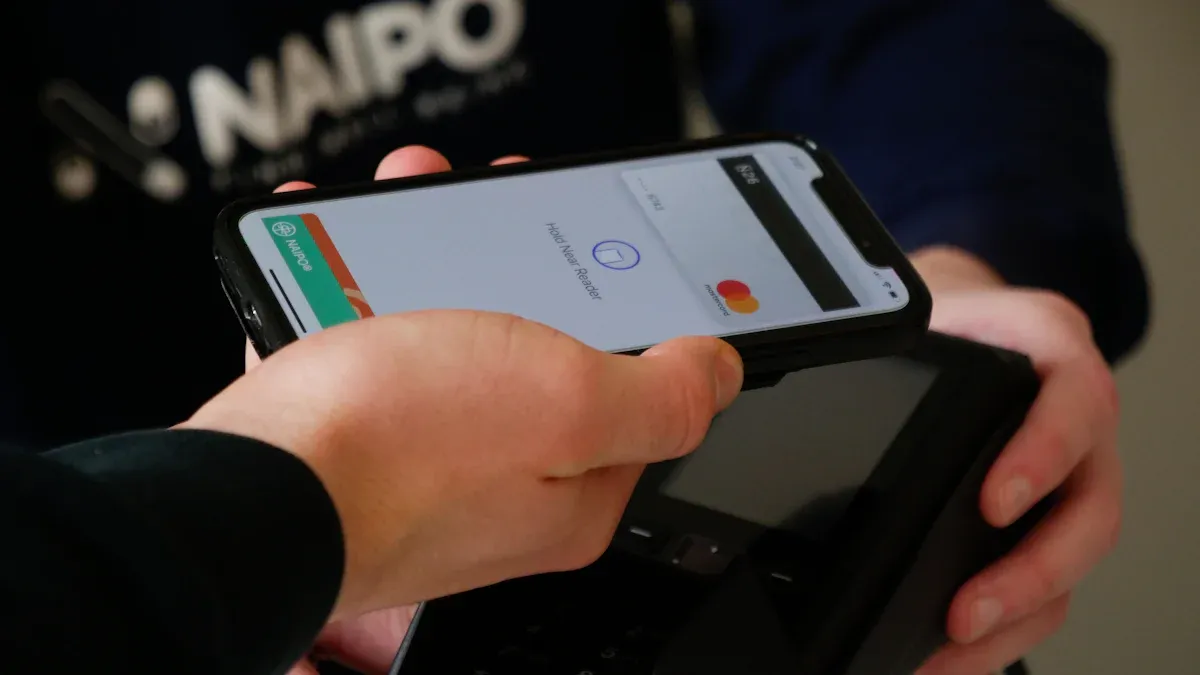- EasyCard
- Trade
- Help
- Announcement
- Academy
- SWIFT Code
- Iban Number
- Referral
- Customer Service
- Blog
- Creator
Are There Fees for Transferring Money with Apple Pay? A Complete Fee Breakdown

Image Source: unsplash
In most cases, using Apple Pay is free. It is particularly common for in-store purchases. Data shows that in 2024, Apple Pay accounted for about 54% of in-store mobile wallet transactions in the U.S., leading the market.
Key Insight: Whether Apple Pay transfer fees apply depends on several critical factors:
- Payment Method: Using a debit card or credit card.
- Transfer Type: Conducting peer-to-peer transfers or international remittances.
- Withdrawal Speed: Choosing standard transfer or instant transfer.
Key Points
- Apple Pay is typically free for in-store purchases, and peer-to-peer transfers using a debit card or Apple Cash balance are also free.
- Instant withdrawals from Apple Cash incur a 1.5% fee, but standard transfers are free.
- International remittances are processed through third-party services, with fees including service charges and exchange rate margins.
- Merchants accepting Apple Pay do not incur additional fees, and consumers pay no surcharges.
Domestic Peer-to-Peer Transfer (Apple Cash) Fees

Image Source: unsplash
In the U.S., users can use Apple Cash through the Messages (iMessage) app for peer-to-peer transfers. This is a highly convenient way to send money. However, the associated fees depend on the funding source and withdrawal speed chosen by the user.
Important Note: Apple Cash’s peer-to-peer transfer feature is currently only available in the U.S.. These services are provided by Green Dot Bank and require users to be U.S. residents aged 18 or older. Therefore, the fees and rules discussed in this section apply to users in the U.S.
Free Transfer Methods
The most cost-effective transfer method is completely free. When users choose either of the following funding sources, Apple does not charge any fees:
- Linked Debit Card: Transferring directly from a user’s bank account via a debit card.
- Apple Cash Balance: Using funds already in the Apple Cash account for transfers.
By selecting these methods, users can send money to friends or family without worrying about additional costs.
Credit Card Transfer Fees
This is a common question, but the answer is clear. Since 2019, Apple has discontinued support for using credit cards to fund Apple Cash peer-to-peer transfers. This policy change aims to help users avoid high “cash advance” fees and related interest that credit card companies might charge.
As a result, users can no longer directly use a credit card for Apple Cash peer-to-peer transfers. This also means the 3% standard fee that existed in the past no longer applies to Apple Cash.
To provide clarity on the market, we can compare credit card transfer fees for other major payment platforms:
| Platform | Credit Card P2P Transfer Fee |
|---|---|
| Venmo | 3% |
| PayPal | 2.9% + $0.30 |
| Cash App | 3% |
This comparison shows that Apple’s decision effectively helps users avoid significant potential costs.
Balance Withdrawal Fees
When users receive funds in their Apple Cash account, they can withdraw the balance to a linked bank account. There are two options, each with different fees and delivery times.
- Standard Transfer
- Fee: Free
- Delivery Time: Typically takes 1 to 3 business days. Note that banks do not process transfers on weekends or holidays, which may extend the actual delivery time. If funds are not received after 3 business days, users should contact Apple Support.
- Instant Transfer
For example, if a user instantly transfers $1,000, the system will charge a $15 fee ($1,000 x 1.5%), and the bank account will receive $985. For a $10 transfer, the minimum fee of $0.25 applies. For users prioritizing speed, this is a convenient but costly option.
Comprehensive Breakdown of Apple Pay Transfer Fees: International Remittances
Apple Pay itself does not directly offer cross-border remittance services. However, users can conveniently complete international transfers through third-party remittance apps that integrate Apple Pay as a payment option. The fee structure for these Apple Pay transfer fees is more complex than domestic transfers.
International Remittance Fee Structure
When using third-party services for international remittances, the total cost typically consists of two core components:
Fee Breakdown: Total Cost = Service Fee + Exchange Rate Margin (Foreign Exchange Fee)
- Service Fee: This is the direct fee charged by the remittance platform for processing the transaction. It may be a fixed amount or a percentage of the transfer amount.
- Exchange Rate Margin: The exchange rate offered by the platform usually slightly differs from the market mid-rate. This margin is a hidden cost through which the platform earns a profit.
Factors Affecting Fees
The total cost of international remittances varies based on several factors, and users should consider these when selecting a service.
First, different remittance providers have varying fee structures. Many popular international remittance platforms, such as Wise, PayPal, and Panda Remit, support Apple Pay as a payment method. When initiating a transfer in these apps, the final fees are clearly displayed.
Second, fees fluctuate based on the following factors:
- Transfer Amount: Higher amounts result in higher service fees when calculated as a percentage.
- Destination Country and Currency: Transfers to certain countries or conversions to less common currencies may incur higher fees.
- Funding Source: When funding a transfer from a bank account, the user’s issuing bank may also charge an international transaction fee.
According to a 2024 industry report, the global average cost for sending a $200 international remittance is about 6.65%. Traditional channels may have higher fees.
| Remittance Channel | Fee Range (for a $200 Transfer) |
|---|---|
| Traditional Money Transfer Operators (MTOs) | 4% to 10% |
| Bank Wire Transfers | 4% to 18% |
This comparison shows that modern digital remittance platforms integrated with Apple Pay are typically more cost-effective than traditional bank channels.
Merchant Payment Fees

Image Source: unsplash
When it comes to using Apple Pay for payments at retail stores, restaurants, or online shops, the fee discussion splits into two perspectives: Do consumers pay anything? And how much do merchants bear?
Consumer Side: Zero Fees
For consumers, the answer is straightforward: Using Apple Pay for payments at merchants is completely free. Whether tapping an iPhone at a terminal in-store or completing an online purchase within an app, consumers do not incur any additional fees for using this convenient service.
Apple’s official policy clearly states this. Its merchant agreements typically include clauses prohibiting merchants from charging extra fees to customers using Apple Pay.
Apple’s policy explicitly states that merchants must not take any actions to discourage customers from using Apple Pay or put it at a disadvantage compared to other payment methods.
This means merchants cannot directly tell customers choosing Apple Pay, “You need to pay an extra X% fee.” However, merchants may indirectly cover their transaction costs in other ways:
- No Direct Surcharges: Merchant agreements typically prohibit directly imposing surcharges on Apple Pay transactions.
- Indirect Cost Coverage: Merchants may subtly adjust pricing for all goods to spread transaction processing costs across all customers. This is a compliant and common business practice.
Thus, as a consumer, you can confidently use Apple Pay, enjoying its security and convenience without worrying about unexpected fees on your bill.
Merchant Side: Standard Transaction Fees
For merchants, the situation is more complex. A common misconception is that accepting Apple Pay incurs an additional “Apple fee.” This is not true.
Key Fact: Apple does not charge merchants any fees for accepting Apple Pay payments. The merchant’s costs come from the standard card transaction agreements with their payment processors.
In other words, when a customer uses Apple Pay, they are essentially using a credit or debit card linked to their Apple Wallet through a highly encrypted channel. Therefore, the fees merchants pay are very similar to those for processing a regular chip card transaction.
These fees, often called the “Merchant Discount Rate,” consist of multiple components and are deducted from the total transaction amount. According to industry data, the total fee typically ranges between 1.5% to 3.5%.
The main components include:
- Interchange Fee: The largest portion, charged by the issuing bank to cover the risk and cost of the transaction. The rate varies based on card type (e.g., rewards card, business card) and transaction method (online or in-person), ranging from 1.10% + $0.10 to 3.15% + $0.10.
- Assessment Fee: Charged directly by card networks (e.g., Visa, Mastercard) for using their network, typically between 0.14% to 0.165%.
- Processor Markup: The profit charged by the payment service provider (e.g., Square, Stripe) for processing the transaction.
Notably, Apple does charge a fee per transaction, but this is paid by the issuing bank, not the merchant. Apple charges the issuing bank 0.15% of the transaction amount as compensation for providing and maintaining its secure tokenization technology.
For a clearer understanding, we can refer to the fee structures of some major payment processors. For example, Square charges 2.6% + $0.10 for contactless payments completed via Apple Pay.
| Payment Method | Typical Fee Structure (Square Example) | Security Level |
|---|---|---|
| Apple Pay (Contactless) | 2.6% + $0.10 | Very High |
| Chip Card (Inserted) | 2.6% + $0.10 | High |
| Magnetic Stripe Card (Swiped) | 2.6% + $0.10 | Medium |
| Manual Entry | 3.5% + $0.15 | Lower |
As shown in the table, Apple Pay and other contactless payment methods have fees equivalent to secure chip card transactions and are often cheaper than higher-risk manual entry transactions. For merchants, accepting Apple Pay not only incurs no additional costs but also enhances transaction security and customer experience.
Fee Summary and Money-Saving Tips
To help users better understand the fees and save on costs, this section provides a clear fee overview and practical money-saving tips.
Fee Quick Reference Table
The following table summarizes the core fees involved in different Apple Pay usage scenarios. Users can quickly reference it to make informed payment decisions.
| Usage Scenario | Fee | Key Notes |
|---|---|---|
| Domestic Peer-to-Peer Transfer (Debit Card) | Free | Transfers using a linked debit card or Apple Cash balance incur no fees. |
| Apple Cash Instant Withdrawal | 1.5% | Speed comes at a cost, with a minimum of $0.25 and a maximum of $15. |
| International Remittance | Variable | Fees are charged by third-party providers, including service fees and exchange rate margins. |
| Merchant Purchase Payments | Free | Consumers pay no additional fees when using Apple Pay for in-store or online shopping. |
Money-Saving Tips and Recommendations
Understanding the rules for Apple Pay transfer fees can help you easily avoid unnecessary expenses. The core strategy is to plan ahead rather than make impromptu decisions.
Key Advice: For users not sensitive to fund delivery times, patience is the best way to save money. Once a standard transfer is selected, it cannot be changed to an instant transfer.
Follow these tips to maximize Apple Pay’s convenience while minimizing costs:
- Prioritize Debit Cards: For peer-to-peer transfers, always choose a linked debit card or Apple Cash balance as the funding source. This is the most straightforward free option.
- Plan Withdrawal Timing: Unless you urgently need funds, opt for “Standard Transfer” to withdraw Apple Cash balance to your bank account. While it takes 1-3 business days, it avoids the 1.5% fee entirely. Currently, no specific bank cards waive this instant transfer fee.
- Compare Providers for International Remittances: Before sending an international transfer, compare total fees across different third-party remittance apps (e.g., Wise). Pay attention to both service fees and the difference between the offered exchange rate and the market mid-rate.
The article’s core conclusion is clear: For daily shopping and peer-to-peer transfers using a debit card, Apple Pay is typically free.
The Apple Pay transfer fees users need to watch for mainly arise in specific scenarios: choosing “Instant Transfer” incurs a 1.5% fee, while international remittances through third-party platforms involve service fees and exchange rate costs.
With Apple Pay achieving 41% significant growth from 2022 to 2024, users can effectively avoid extra costs and fully enjoy its security and convenience by selecting the appropriate withdrawal method based on their funding needs.
FAQ
Are Apple Pay and Apple Cash the Same Thing?
No. Apple Pay is a payment technology used for in-store or online purchases. Apple Cash is a peer-to-peer transfer service currently available only in specific regions like the U.S., and it is not available to users in mainland China.
Why Can’t I Use a Credit Card for Peer-to-Peer Transfers?
Apple has discontinued support for using credit cards to fund Apple Cash peer-to-peer transfers. This decision helps users avoid “cash advance” fees and high interest rates that credit card companies may charge, protecting consumer interests.
Is There a Way to Avoid the 1.5% Instant Withdrawal Fee?
Currently, there is no way to avoid it. All eligible debit cards issued by banks incur a 1.5% fee (minimum $0.25, maximum $15) when selecting “Instant Transfer.” The only free option is choosing the 1-3 business day standard transfer.
Do Merchants Incur Extra Fees for Accepting Apple Pay?
No. Apple does not charge merchants extra fees. Merchants pay standard card transaction processing fees, similar to those for processing physical chip card transactions, which are charged by their payment service providers and issuing banks.
*This article is provided for general information purposes and does not constitute legal, tax or other professional advice from BiyaPay or its subsidiaries and its affiliates, and it is not intended as a substitute for obtaining advice from a financial advisor or any other professional.
We make no representations, warranties or warranties, express or implied, as to the accuracy, completeness or timeliness of the contents of this publication.




Contact Us
Company and Team
BiyaPay Products
Customer Services
is a broker-dealer registered with the U.S. Securities and Exchange Commission (SEC) (No.: 802-127417), member of the Financial Industry Regulatory Authority (FINRA) (CRD: 325027), member of the Securities Investor Protection Corporation (SIPC), and regulated by FINRA and SEC.
registered with the US Financial Crimes Enforcement Network (FinCEN), as a Money Services Business (MSB), registration number: 31000218637349, and regulated by FinCEN.
registered as Financial Service Provider (FSP number: FSP1007221) in New Zealand, and is a member of the Financial Dispute Resolution Scheme, a New Zealand independent dispute resolution service provider.



















